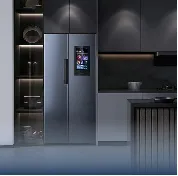
Direct‑Cool vs Frost‑Free Refrigerators: In‑Depth Pros & Cons and Ideal Use Cases

Hey there! If you're shopping for a new refrigerator, you've probably encountered a jungle of technical terms like "direct-cool" and "frost-free." It’s like trying to pick between two smartphones – both keep things running, but they do it in totally different ways. Today, we’re breaking it all down, step by step. I'll help you navigate these cooling technologies so you know exactly which one fits your kitchen—and lifestyle—perfectly. Let's dive in.
How Refrigerators Work: The Basics
To truly "get" why these cooling methods differ so much, think of your refrigerator as a hardworking air-conditioner for your food. Both types use a coolant system (think Freon) to cycle cold air, pulling heat from the inside to the outside. But how they distribute that cold air? That's the big difference, and it dictates everything from defrosting chores to energy bills.
Direct-Cool Refrigerators: Simple Yet Traditional
What They Are & How They Work
Direct-cool is like that no-frills compact car you loved years ago. It’s straightforward: cold coils inside the freezer create chilly air that drifts downward naturally into the fridge through convection—like heat rising but in reverse. But here’s the trade-off: cold pockets can form near the freezer while warmer pockets linger toward the bottom. That unevenness means:
- Pros : It's gentle on your wallet initially. They cost less to buy and sip rather than gulp power.
- Cons : Ice builds up regularly. Defrosting becomes part of your monthly routine—shut off the fridge, empty it, and let ice melt for 4–6 hours.
Who’s It For?
Got a smaller family of 2–3? Or live somewhere with natural humidity that fruits and veggies love? Or honestly, just hate complicated gadgets? This chill, manual system could be your match. Great for:
- College dorm rooms
- Studio apartments
- Offices or garages
Frost-Free Refrigerators: Sleek & Smart
Tech Behind the Frost-Free Magic
Imagine your refrigerator with an in-built thermostat army: sensors track temperature, automatic heaters kick in to melt frost before it builds up, and quiet, tiny fans blow crisp air evenly throughout the shelves. That’s frost-free technology. No chipping ice with spatulas here!
- Pros : Forget defrosting. Temperature control is so precise it’s easier to store fresh salads and delicate cheeses.
- Cons : These energy-efficient appliances might push up your energy bill slightly, especially older models.
Ideal Users? Everyone Else!
This fridge is designed for modern hustle. Big family? Frozen pizza lover? You need reliable, even cooling that matches daily chaos. This is a winner for:
- Homes needing large capacities (400–650L)
- Busy parents
- Hot climates
- People using smart home features
Head-to-Head: Breaking Down Key Differences
| Feature | Direct-Cool | Frost-Free |
|---|---|---|
| Power Use | Lower (ideal for budget shoppers) | Higher but optimized for consistent cooling |
| Defrosting | Manual – every 1-2 months | Zero effort – fully automatic |
| Humidity Control | Natural, preserves fruits/veggies | Slightly dry – use containers |
| Noise Level | Quiet (as a sleeping cat) | Quiet fans occasionally purr |
| Price | $300–$600 | $500–$1200+ |
How to Choose Your Perfect Fridge
Step 1 : Consider how much food you need chilled daily. If it’s mostly drinks or leftovers, direct-cool does fine. Families of 4+? Frost-free all the way.
Step 2 : Measure your space! Both types come compact to side-by-side monsters. Note the inches so delivery day doesn’t become a disaster.
Step 3 : Don’t ignore climate. Humid weather favors direct-cool for fresh food; dry zones prefer frost-free for durability.
Step 4 : Check star ratings on energy bills. That extra cash upfront on frost-free might save money over time.
Top Brands & Technologies in the Game
Advanced Cooling Tech
Modern giants like TCL use innovations like Multi Air Flow™ to improve frost-free performance—spreading air evenly so every inch stays crisp, even in packed sections. Others use ion sterilization (TCL’s AAT) to banish fridge odors and prolong food life.
Brand Reliability
- Budget hero : Hisense, Haier (reliable direct-cool)
- Mid-tier : TCL, LG (solid frost-free options)
- Splurge-tier : Bosch, Samsung (high-end models with Wi-Fi temp control)
Real Users Speak: Case Studies
Amanda, NYC : “I upgraded to frost-free 2 years ago in my tiny studio. Best. Decision. Ever. Morning smoothies stay icy without defrosting chaos.”
Marcus, Texas : “I use a direct-cool for our garage drinks fridge—less humidity means soda cans don’t sweat. Perfect for BBQ season.”
Maintenance 101: Make Your Fridge Last
- Direct-cool : Monthly wipe-downs, defrost coils religiously.
- Frost-free : Dust vents quarterly, check filters.
- Both : Keep door seals clean. Tight seals = 20% energy savings!
Future Cooling Tech Sneak Peek
Coming soon: solar cooling hooks via ecofriendly tech , AI sensors that adjust temperature when you add groceries, and more.
Your Decision Cheat Sheet
Choose Direct-Cool if :
- Budget matters most
- You cook fresh ingredients often
- Small space available
Choose Frost-Free if :
- Time is short (hello, defrost-free weekends!)
- You store dairy, meat, frozen foods
- You want minimal noise/smart controls
And whichever you pick, make sure it fits not just your kitchen—but your day-to-day rhythm. Happy cooling!
Tags:
Recommend Products











